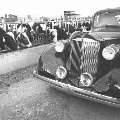|
Re: Aluminum bodied Packards
|
||||
|---|---|---|---|---|
|
Home away from home

|
Hi BDC
Aluminum as a coach building material was preferred to steel for its ease of use. But, it was more expensive than steel so generally not the material of choice for production bodies. Because it was thin sheet stock, while easier to form, it also was easier to deform so dented or damaged more easily, not ideal for fenders, at least for production cars. For luxury car manufacturers, aluminum was used primarily for cast parts where the thickness could be great enough for strength and durability. Pierce-Arrow made cast aluminum bodies for their cars early on and into the teens before switching to composite steel/wood construction. Among custom coachbuilders, Hibbard & Darrin developed a method they named "Sylentlyte" for precise thin-wall casting to build complete bodies, the support structure integrally cast. You will find what were catalogued body styles in the 1910's and 1920's that were aluminum over wood frame. These were built by custom coachbuilders as a production series runs under contract to a car manufacturer. Rarely do they have body builder identity tags as customs do. Willoughby, Judkins, Biddle & Smart and Merrimac Body Co. among other custom coachbuilders supplied these series runs, usually the more expensive closed body styles, as a way to keep their craftsman busy, cover the overhead while still building full customs as the individual orders arose. Fenders, except in rare cases where the design of such was an integral element of a full custom such as parabolic, aircraft style, were steel. There were a number of fender stamping suppliers to the industry who made whatever design the carmaker ordered. Fender style, in combination with radiator and headlights, established the marque's identity. Hoods were the same, except in those custom coach built cases where polished aluminum hood panels were specified as part of the design, which was rare. Aluminum as a coachbuilder material continued in use in England and Europe throughout the 1930's and 1940's, some few into the 1950's. Steve
Posted on: 2017/11/25 9:08
|
|||
|
.....epigram time.....
Proud 1953 Clipper Deluxe owner. Thinking about my next Packard, want a Clipper Deluxe Eight, manual shift with overdrive. |
||||
|
||||

Hello and welcome to Packard Motor Car Information! If you're new here, please register for a free account.








